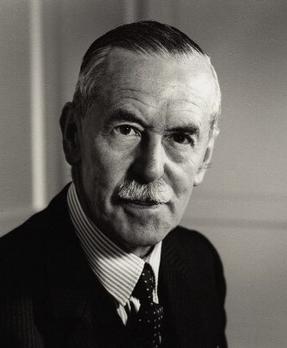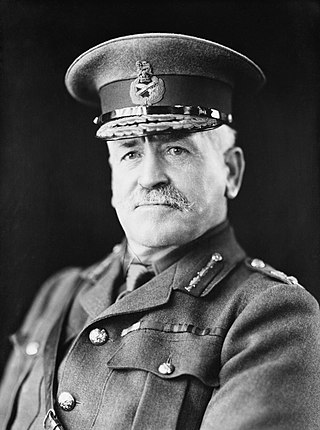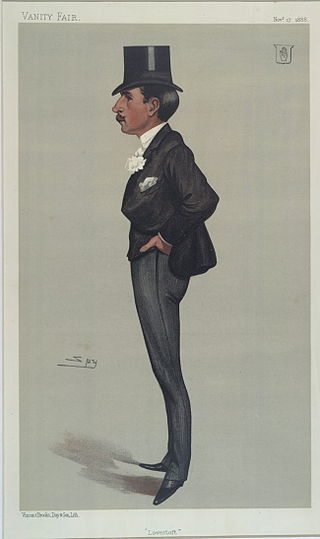
Field Marshal Sir Robert Rich, 4th Baronet was a British cavalry officer. As a junior officer he fought at the Battle of Schellenberg and at the Battle of Blenheim during the War of the Spanish Succession. He was then asked to raise a regiment to combat the threat from the Jacobite rising of 1715. He also served with the Pragmatic Army under the Earl of Stair at the Battle of Dettingen during the War of the Austrian Succession. As a Member of Parliament he represented three different constituencies but never attained political office.

Earl of Gosford is a title in the Peerage of Ireland. It was created in 1806 for Arthur Acheson, 2nd Viscount Gosford.

Earl of Stradbroke, in the County of Suffolk, is a title in the Peerage of the United Kingdom. It was created in 1821 for John Rous, 1st Baron Rous, who had earlier represented Suffolk in the House of Commons.

Sir Noël Vansittart Bowater, 2nd Baronet was the 626th Lord Mayor of London from 1953 to 1954.

General Sir Charles Carmichael Monro, 1st Baronet, was a British Army General in the First World War. He held the post of Commander-in-Chief, India in 1916–1920. From 1923 to 1929 he was the Governor of Gibraltar.

Savile Brinton Crossley, 1st Baron Somerleyton, known as Sir Savile Crossley, Bt, from 1872 to 1916, was a British Liberal Unionist politician who served as Paymaster General from 1902 to 1905.
Joseph Russell Bailey, 1st Baron Glanusk, known as Sir Joseph Bailey, 2nd Baronet, from 1858 to 1899, was a Welsh Conservative Member of Parliament.

There have been four baronetcies created for persons with the surname Miller, two in the Baronetage of England, one in the Baronetage of Great Britain and one in the Baronetage of the United Kingdom. Two of the creations are extant as of 2008.
There have been two baronetcies created for persons with the surname Gooch, one in the Baronetage of Great Britain and one in the Baronetage of the United Kingdom.
There have been three baronetcies created for persons with the surname Clayton, two in the Baronetage of Great Britain and one in the Baronetage of the United Kingdom. One creation is extant as of 2021.

Sir Pierce Thomas Lacy, 1st Baronet, was an English stockbroker.

Sudbourne is a village and civil parish in Suffolk, England, located approximately 2 miles (3 km) north of Orford.
Colonel Sir William Alfred Churchman, 1st Baronet, was an English tobacco manufacturer and public servant.
This is a list of Sheriffs and High Sheriffs of Suffolk.
The High Sheriff of Carlow was the British Crown's judicial representative in County Carlow, Ireland from the 14th century until 1922, when the office was abolished in the new Free State and replaced by the office of Carlow County Sheriff. The sheriff had judicial, electoral, ceremonial and administrative functions and executed High Court Writs. In 1908, an Order in Council made the Lord-Lieutenant the Sovereign's prime representative in a county and reduced the High Sheriff's precedence. However, the sheriff retained his responsibilities for the preservation of law and order in the county. The usual procedure for appointing the sheriff from 1660 onwards was that three persons were nominated at the beginning of each year from the county and the Lord Lieutenant then appointed his choice as High Sheriff for the remainder of the year. Often the other nominees were appointed as under-sheriffs. Sometimes a sheriff did not fulfil his entire term through death or other event and another sheriff was then appointed for the remainder of the year. The dates given hereunder are the dates of appointment. All addresses are in County Carlow unless stated otherwise.
The High Sheriff of Mayo was the British Crown's judicial representative in County Mayo, Ireland from the 16th century until 1922, when the office was abolished in the new Free State and replaced by the office of Mayo County Sheriff. The sheriff had judicial, electoral, ceremonial and administrative functions and executed High Court Writs. In 1908, an Order in Council made the Lord-Lieutenant the Sovereign's prime representative in a county and reduced the High Sheriff's precedence. However, the sheriff retained his responsibilities for the preservation of law and order in the county. The usual procedure for appointing the sheriff from 1660 onwards was that three persons were nominated at the beginning of each year from the county and the Lord Lieutenant then appointed his choice as High Sheriff for the remainder of the year. Often the other nominees were appointed as under-sheriffs. Sometimes a sheriff did not fulfil his entire term through death or other event and another sheriff was then appointed for the remainder of the year. The dates given hereunder are the dates of appointment. All addresses are in County Mayo unless stated otherwise.
The High Sheriff of Donegal was the British Crown's judicial representative in County Donegal in Ulster, Ireland, from the late 16th century until 1922, when the office was abolished in the new Irish Free State and replaced by the office of Donegal County Sheriff. The High Sheriff had judicial, electoral, ceremonial and administrative functions and executed High Court Writs. In 1908, an Order in Council made the Lord-Lieutenant the Sovereign's prime representative in a county and reduced the High Sheriff's precedence. However, the sheriff retained his responsibilities for the preservation of law and order in the county. The usual procedure for appointing the sheriff from 1660 onwards was that three persons were nominated at the beginning of each year from the county and the Lord Lieutenant then appointed his choice as High Sheriff for the remainder of the year. Often the other nominees were appointed as under-sheriffs. Sometimes a sheriff did not fulfil his entire term through death or other event and another sheriff was then appointed for the remainder of the year. The dates given hereunder are the dates of appointment. All addresses are in County Donegal unless stated otherwise.
The High Sheriff of County Waterford was the Sovereign's judicial representative in County Waterford. Initially, an office for a lifetime, assigned by the Sovereign, the High Sheriff became an annual appointment following the Provisions of Oxford in 1258. Besides his judicial importance, the sheriff had ceremonial and administrative functions and executed High Court Writs.
The Sheriff of County Dublin was the Sovereign's judicial representative in County Dublin. Initially, an office for a lifetime, assigned by the Sovereign, the Sheriff became an annual appointment following the Provisions of Oxford in 1258. The first recorded Sheriff was Ralph Eure, appointed in that year. The next recorded Sheriff was Sir David de Offington, who was Sheriff in 1282. Besides his judicial importance, the sheriff had ceremonial and administrative functions and executed High Court Writs.

The Broke, later Broke–Middleton Baronetcy, of Broke Hall in the County of Suffolk, was a title in the Baronetage of the United Kingdom. It was created on 2 November 1813 for Philip Broke, a Rear-Admiral of the Royal Navy. He was the grandson of Robert Broke, nephew of Sir Robert Broke, 1st Baronet, of Nacton, who were both descended from Sir Richard Broke, Chief Baron of the Exchequer during the reign of Henry VIII. The second Baronet was Sheriff of Suffolk in 1844 and his younger brother the third Baronet was Sheriff of Suffolk in 1864. The third Baronet assumed the additional surname of Middleton in 1860 after inheriting the estate of his cousin Sir William Fowle Fowle-Middleton. The title became extinct on his death in 1887.










